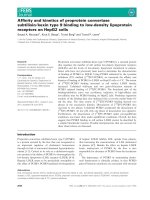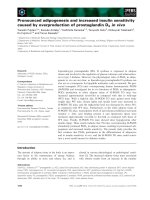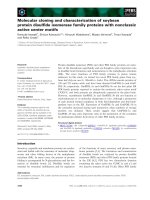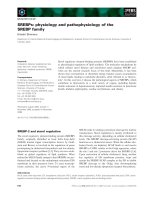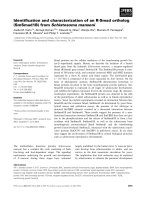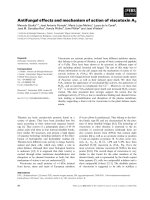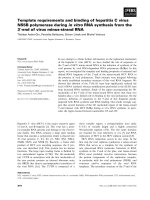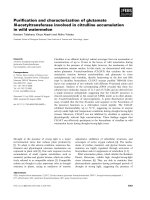Báo cáo khoa học: Substrate recognition and ®delity of strand joining by an archaeal DNA ligase docx
Bạn đang xem bản rút gọn của tài liệu. Xem và tải ngay bản đầy đủ của tài liệu tại đây (338.77 KB, 7 trang )
Substrate recognition and ®delity of strand joining by an archaeal
DNA ligase
Masaru Nakatani
1,2
, Satoshi Ezaki
1,2
, Haruyuki Atomi
1,2
and Tadayuki Imanaka
1,2
1
Department of Synthetic Chemistry and Biological Chemistry, Graduate School of Engineering, Kyoto University;
2
Core Research for Evolutional Science and Technology Program of Japan Science and Technology Corporation, Japan
We have previously identi®ed a DNA ligase (Lig
Tk
)froma
hyperthermophilic archaeon, Thermococcus kodakaraensis
KOD1. The enzyme is the only characterized ATP-depend-
ent DNA ligase from a hyperthermophile, and allows the
analysis of enzymatic DNA ligation reactions at tempera-
tures above the melting point of the substrates. Here we have
focused on the interactions of Lig
Tk
with various DNA
substrates, and its speci®cities toward metal cations. Lig
Tk
could utilize M g
2+
,Mn
2+
,Sr
2+
and Ca
2+
as a m etal cation,
but not Co
2+
,Zn
2+
,Ni
2+
,orCu
2+
. The enzyme displayed
typical Michaelis±Menten steady-state kinetics with an
apparent K
m
of 1.4 l
M
for nicked DNA. The k
cat
value o f t he
enzyme was 0.11ás
)1
. U sing various 3¢ hydroxyl group
donors (L-DNA) and 5¢ phosphate group donors
(R-DNA), we could detect ligation products as short as 16
nucleotides, the products of 7 + 9 nucleotide or 8 + 8
nucleotide combinations at 40 °C.Anelevationintemper-
ature led to a decrease in reaction eciency when short
oligonucleotides were used, suggesting that the formation of
a nicked, double-stranded DNA substrate precede d enzyme-
substrate recognition. Lig
Tk
was not inhibited by the
addition of excess duplex DNA, implying that the enzyme
did not bind strongly to the double-stranded ligation prod-
uct after nick-sealing. In terms of reaction ®delity, Lig
Tk
was
found to ligate various substrates with mismatched base-
pairing at the 5¢ end of the nick, but did not show activity
towards the 3¢ mismatched substrates. Lig
Tk
could not seal
substrates with a 1-nucleotide o r 2-nucleotide g ap. Small
amounts of ligation products were detected with DNA
substrates containing a single nucleotide insertion, relatively
more with the 5¢ insertions. The results revealed the impor-
tance of proper base-pairing a t the 3¢ hydroxyl side of the
nick for the ligation reaction by Lig
Tk
.
Keywords: archaea; DNA ligase; hyperthermophile;
Thermococcus.
DNA ligases (EC 6.5.1.1 and EC 6.5.1.2) are universally
found in bacteria, eukaryotes and archaea. In addition, they
are a lso found i n viruses and bacteriophages [ 1±5]. DNA
ligases catalyse the phosphodiester bond formation between
adjacent 3¢ hydroxyl and 5 ¢ phosphate groups at a single-
strand break in double-stranded DNA [5,6]. They are
essential enzymes for maintaining the integrity of the
genome during DNA replication [7], DNA excision rep air
[8] a nd DNA recombination [9]. DNA strand breaks are
commonly generated as reaction intermediates in these
events, and the sealing of these breaks depends solely on the
proper function of DNA ligase [2]. Therefore DNA ligases
are indispensable enzymes in all organisms.
DNA ligases fall into two groups, ATP-dependent DNA
ligases and N AD
+
-dependent DNA ligases, on the basis o f
the required cofactor for ligase±adenylate formation [2,5,6].
ATP-dependent enzymes have been found in viruses,
bacteriophages, eukaryotes, a rchaea and, recently, i n bac-
teria, whereas NAD
+
-dependent enzymes h ave been f ound
exclusively in bacteria [2,3,5]. There is high similarity among
the ligases within the ATP-dependent groups [10] or
NAD
+
-dependent groups [11,12]. However, enzymes
between the two groups show no similarity, with the
exception of the AMP-binding site [10]. I t is now accepted
that both ATP-dependent and NAD
+
-dependent DNA
ligases catalyse their reactions through a common mecha-
nism [13]. The ligation reaction proceeds through t hree
steps. In the ®rst step, a ttack on ATP or N AD
+
by the
enzyme results in release of PPi or NMN from the cofactor
and formation of enzyme±adenylate through t he covalent
addition of AMP to the conserved AMP-binding site lysine
of the protein. In the second step, the AMP i s transferred
from the protein to the 5¢ phosphate group of the nick on
the DNA t o form DNA ±adenylate . In t he third step, the
enzyme catalyses phosphodiester bond formation with
concomitant release of free AMP from the DNA±adenylate
[2,5,6,13].
Catalytic activity of DNA ligase is dependent on
appropriate divalent cations and DNA substrates. In
general, DNA ligases can utilize M g
2+
and s everal o ther
divalent cations that belong to the fourth period of the
elements [14±20]. The interaction between DNA ligase and
its DNA substrates has been examined from various
viewpoints, such as substrate length, and a ctivity towards
substrates with gaps, mismatches, or insertions. S everal
reports have shown that some enzymes can catalyse the
Correspondence to T. Imanaka, Department of Synthetic Chemistry
and Biological Chemistry, Graduate School of Engineering, Kyoto
University, Yoshida-Honmachi, Sakyo-ku, Kyoto 606-8501, Japan.
Fax: +81 75 753 4703, Tel.: +81 75 753 5568,
E-mail:
Abbreviations:Lig
Tk
, DNA ligase from Thermococcus kodakaraensis
KOD1; L-DNA, oligonucleotide as 3¢ hydroxyl group donor;
R-DNA, oligonucleotide as 5¢ phosphate group donor; T-DNA,
complementary oligonucleotide to L-DNA and R-DNA.
Enzymes: DNA ligase (EC 6.5.1.1 and EC 6.5.1.2).
(Received 25 July 2001, revised 20 November 2001, accepted 21
November 2001)
Eur. J. Biochem. 269, 650±656 (2002) Ó FEBS 2002
ligation reaction with gapped, inserted or mismatched
substrates [15±17,19±27].
Although a signi®cant amount of k nowledge o n DNA
ligases from bacteria, eukaryotes and viruses has accumu-
lated, archaeal enzymes h ave only recently been reported.
Shuman and coworkers have identi®ed an ATP-dependent
DNA ligase from Methanobacterium therm oautotrophicum
[18]. W e have report ed the exa mination of a DNA ligase
(Lig
Tk
)fromThermococcus kodakaraensis KOD1, a hyper-
thermophilic archaeon [3]. Lig
Tk
displayed two uniq ue
features. One was t hat the enzyme, although belonging to
the family of ATP-dependent DNA ligases, could utilize
NAD
+
as a c ofactor. The other was the extreme thermo-
stability of Lig
Tk
: nick-sealing was observed at temperatures
up to 100 °C. The thermostability of the enzyme provide s a
means to examine DNA ligation reactions at temperatures
above the melting point of the DNA substrates. As little is
known about DNA ligases from archaea o r f rom hyper-
thermophiles, we have examined Lig
Tk
focusing on the
following aspects: (a) its divalent cation speci®city; (b) the
effect of temperature on the interaction between enzyme
and DNA substrate; (c) t he ability of the enzyme to
discriminate gapped, inserted and mismatched ends at the
nick.
MATERIALS AND METHODS
Puri®cation of recombinant Lig
Tk
The DNA ligase gene (lig
Tk
)fromT. kodakaraensis KOD1
was s ubcloned into an expression vector, pET-21a(+)
(Novagen) [3]. The resulting plasmid pET-lig was intro-
duced into Escherichia coli BL21-CodonPlus(DE3)-RIL
(Stratagene). The t ransformants were cult ivated in Luria±
Bertani medium [ 28] containing 50 lgámL
)1
ampicillin at
37 °C until the optical density at 660 nm reached 0.8.
Isopropyl-
D
-thiogalactopyranoside was added at a ®nal
concentration of 1 m
M
to in duce lig
Tk
gene expression for
7h.
Cells were harvested by centrifugation (5000 g,15min,
4 °C), washed with buffer A (50 m
M
Tris/HCl pH 7.5) , and
then resuspended in buffer A. The cells were disrupted by
sonication and the super natant was obtained by centrifu-
gation (12 000 g,30min,4°C). T he soluble fraction of cell-
free extract was heat-treated at 80 °C for 30 min and the
precipitate was removed by centrifugation (12 000 g,
30 min, 4 °C) to obtain thermostable proteins. The super-
natant was applied to a ResourceQ column (Amersham
Pharmacia Biotech) equilibrated with buffer A. As Lig
Tk
did not bind to the r esin, the ¯ow-through fractions were
collected, dialysed with buffer B (50 m
M
Mes/KOH
pH 6.0) and applied to a ResourceS column (Amersham
Pharmacia Biotech) equilibrated with buffer B. After
washing with buffer B, the enzyme was eluted with a linear
gradient of 0±1.0
M
KCl in buffer B. The peak fractions
containing Lig
Tk
, which eluted between 0.10 and 0.14
M
KCl, were concentrated by using C entricon-30 (Millipore).
The enzyme solutio n was applied to a gel ® ltration column
(Superdex 200 HR 10/30, Amersham Pharmacia B iotech)
equilibrated with buffer C (50 m
M
Mes/KOH pH 6.0,
100 m
M
KCl) and eluted with t he same buffer. The active
fractions were dialysed with buffer A and used as puri®ed
Lig
Tk
in following experiments. The protein c oncentration
was determined with the Bio-Rad protein assay system with
BSA as a standard.
DNA substrates
DNA ligase a ctivity measurements w ere c arried out with
synthesized oligonucleotides. The substrate used in most
activity measurements was composed of two oligonucleo-
tides (L-DNA and R-DNA) and a complementary
oligonucleotide (T-DNA). A phosphate group was present
at the 5¢ terminus of R-DNA. Deletions, i nsertions
and m utations were introduced to the L-DNA(40),
R-DNA(30) andT-DNA(80) whennecessary. T he sequences
of the oligonucleotides are listed in F ig. 1. In addition, a
complete duplex DNA added to the reaction in Fig. 3B
consists of 50-mer DNA-A (5¢-CCACTCGACGAGC
TTCTTGCCTTCACAGACGAGGACTTGGGAAGCT
CACG-3¢) and 50-mer DNA-B (5¢-CGTGAGCTTCCCA
AGTCCTCGTCTGTGAAGGCAAGAAGCTCGTCGA
GTGG-3¢).
Radiolabelling of oligonucleotides
In the case of DNA ligase assays with labelled substrates,
R-DNA was radiolabelled. A nonphosphorylated R-DNA
Fig. 1. Schematic r epresentation of oligonucleotides used for DNA ligase assays. The 5¢ phosphate at the nick is indicated by P. The hyphens in
T-DNA were inserted i n the se quence sole ly for a lignment. DN A ligation re actions we re performed u sing th ese oligonucle otides or th eir derivat ives
indicated in the respective ®gures.
Ó FEBS 2002 Properties of an archaeal DNA ligase (Eur. J. Biochem. 269) 651
was synthesized and phosphorylated at its 5¢ terminus using
[c-
32
P]ATP. The oligonucleotide (10 pmol) was phosphor-
ylated and radiolabelled b y incubation with 1.85 MBq
[c-
32
P]ATP (Amersham Pha rmacia Biotech) and 1 0 U T 4
polynucleotide k inase (MEGALABEL
TM
, T akara Shuzo,
Kyoto, Japan) at 37 °C for 30 min. The reaction product
was puri®ed by centrifugation through a CENTRI-SEP
Spin Column (Perkin-Elmer Applied Biosystems).
DNA ligase assays
Ligation activity was measured by using the DNA sub-
strates described above. Unless otherwise stated, ligation
reaction mixtures (20 lL) contained 20 m
M
Bicine/KOH
pH 8 .0, 15 m
M
MgCl
2
,20m
M
KCl, 1 m
M
ATP, 10 l
M
L-DNA, 10 l
M
R-DNA, 5 l
M
T-DNA, and 200 n
M
Lig
Tk
.
The enzyme and other constituents of the reaction mixture
were incubated separately at the desired temperature, and
reactions were initiated by mixing the two solutions.
Standard reactions were carried out at 80 °C for 2 h or at
40 °C for 4 h . The reactions were stopped by addition of
30 lL loading buffer [98% (v/v) formamide, 10 m
M
EDTA,
0.05% (w/v) xylene cyanol FF] and cooling in ice water. The
products (12 lL) were heated at 95 °C for 3 min and then
electrophoresed on a denaturing 6% polyacrylamide/7
M
urea gel. Super Reading DNA Sequence PreMix Solution
(6%) (Toyobo, Osaka, Japan) and Gel-Mix Running Mate
Tris/borate/EDTA buffer (Gibco BRL) w ere used for
electrophoresis. The gel was stained with ethidium b romide.
In experiments determining the kinetic parameters of Lig
Tk
,
ligation reaction mixtures (20 lL) contained 20 m
M
Bicine/
KOH pH 8.0, 15 m
M
MgCl
2
,20m
M
KCl, 1 m
M
ATP, and
50 n
M
Lig
Tk
. DNA substrate [L-DNA(40), R-DNA(30),
and T-DNA(80)] were added at various concentrations in
the range 0.5±4 l
M
.
With radiolabelled DNA substrates, 0.1 l
M
L-DNA,
0.1 l
M
T-DNA and 0.1 l
M
labelled R-DNA were used.
After electrophoresis, the gel was dried and labelled oligonu-
cleotides were detected by autoradiography. The ligation
products were quanti®ed by densitometric analysis and
QUANTITYONE
software (pdi, Huntington Station, NY,U SA).
RESULTS AND DISCUSSION
In our previous study, w e identi®ed an ATP-dependent
DNA ligase (Lig
Tk
) from a hyperthermophilic archaeon,
T. kodakaraensis KOD1 [3]. It was shown that Lig
Tk
was
able to: (a) catalyse DNA nick-sealing at temperatures up to
100 °C; (b) utilize NAD
+
as a cof actor; and ( c) form a n
Fig. 3. Turnover of Lig
Tk
. The reactions were performed with nonla-
belled oligonucleotides as described in Materials and metho ds. (A) The
relationship between template DNA con centratio n and the prod uction
of 70-mer DNA. Reaction mixtures (20 lL) containing 20 m
M
Bicine/
KOH pH 8.0, 15 m
M
MgCl
2
,20m
M
KCl, 1 m
M
ATP, 5 l
M
L-DNA(40), 5 l
M
R-DNA(30), 200 n
M
Lig
Tk
and the indicated
amount of T-DNA(80) were incubated at 80 °Cfor2h.(B)Theeects
of addition of excess duplex DNA on the ligation reaction. Reaction
mixtures (20 lL) contained 20 m
M
Bicine/KOH pH 8.0, 15 m
M
MgCl
2
,20m
M
KCl, 1 m
M
ATP, 10 l
M
L-DNA(40), 10 l
M
R-DNA(30), 5 l
M
T-DNA(80) and 200 n
M
Lig
Tk
, with (right side) or
without (left side) exce ss duplex D NA. The d uplex DN A was a m ixture
of 10 l
M
of 50 -mer DNA-A and 10 l
M
of 50-mer DNA-B. T hese
mixtures were incubated at 80 °C and then the products were sampled
at 5, 15, 30, 60 and 120 min after the start o f the reaction.
Fig. 2. Divalent ca tion speci®city of Lig
Tk
. Ligation reaction s were
performed with dierent divalent cations. R eaction mixtures (20 lL)
containing 20 m
M
Bicine/KOH pH 8.0, 1 m
M
ATP, 0.1 l
M
L-DNA(40), 0.1 l
M
T-DNA(80), 0.1 l
M
labelled R-DNA(30), 2 00 n
M
Lig
Tk
and 15 m
M
of the indicated divalent cation were incubated at
80 °Cfor2h.
652 M. Nakatani et al. (Eur. J. Biochem. 269) Ó FEBS 2002
enzyme±AMP complex in the presence of ATP and absence
of DNA substrate. As still little i s known about DNA
ligases from archaea [3,18] or from hyperthermophiles
[3,19], we have carried out biochemical and kinetic charac-
terization of Lig
Tk
.
Effects of divalent metal cations on the ligation reaction
We have previously shown that Mg
2+
supported the DNA
ligase activity of Lig
Tk
[3]. Here, we substituted various
divalent metal ca tions for Mg
2+
at a concentration of
15 m
M
(Fig. 2 ). In comparison to Mg
2+
(100%), Lig
Tk
could use Mn
2+
(65%) and Sr
2+
(40%) as an alternative
cation cofactor to support ligase a ctivity. The enzyme was
less active with Ca
2+
(9%), whereas Co
2+
and Zn
2+
failed
to support ligation. The optimal cation concentration for
Mg
2+
was 15 m
M
[3], and those for Mn
2+
,Sr
2+
and Ca
2+
were 25 m
M
,25m
M
and 5 m
M
, respectively (data not
shown). As little difference was found in activity levels
between concentration s of 5 m
M
and 25 m
M
, t he data in
Fig. 2 accurately re¯ect the cation preference of L ig
Tk
.We
observed i nhibitory effects on activity only in the case of
Ca
2+
at concentrations above 4 0 m
M
.Lig
Tk
could not use
Ni
2+
and Cu
2+
, which have been reported not to support
activity in previously repo rted DNA ligases (data not
shown) [15±20]. The results suggest that Lig
Tk
preferred
alkaline earth metal ions as a cation cofactor.
All previously reported DNA ligases have been sh own to
use Mg
2+
and Mn
2+
[14±20]. Utilization of Ca
2+
and
Co
2+
differ among DNA ligases. It has been reported that
theenzymefromThermus thermophilus [20] used Ca
2+
, but
not Co
2+
, that the enzymes from Chlorella virus PBCV-1
[16], V accinia v irus [15] and M. thermoautotrophicum [18]
could use Co
2+
, but not Ca
2+
, and that the enzymes from
Haemophilus in¯uenzae [17] and Aquifex aeolicus [19] could
use neither Ca
2+
nor Co
2+
.Thereseemstobenocommon
tendency a mong DNA ligases in terms o f divalent cation
speci®city. The use of Sr
2+
has not been examined for other
enzymes.
Interaction between Lig
Tk
and DNA substrates
We have reported previously that Lig
Tk
displayed DNA
ligase activity at temperatures up to 100 °C [3]. However, we
observed that the ligation reaction ceased before the
complete consumption of the substrates, raising the possi-
bility that Lig
Tk
could not turnover. We addressed this
possibility b y examining the ligation reaction by Lig
Tk
with
various amounts of template DNA. As shown in Fig. 3A,
the a mount of the ligation product produced by Lig
Tk
depended s trictly on the amount of T-DNA(80) in the
reaction mixture. When T-DNA(80) was present in the
reaction mixture at a concentration of 20 l
M
, the substrates,
L-DNA(40) and R-DNA(30), were consumed almost
completely and ligated by 0.2 l
M
of Lig
Tk
. The concentra-
tions of L-DNA(40) and R-DNA(30) were 5 l
M
each and
considerably higher than that of Lig
Tk
, indicating that Lig
Tk
turned over. We further performed a kinetic analysis of
Lig
Tk
using various concentrations of L-DNA(40),
R-DNA(30) and T-DNA(80) as substrates. The enzyme
displayed typical Michaelis±Menten steady-state kinetics
with an apparent K
m
of 1.4 l
M
for nicked DNA. The k
cat
value of the enzyme was 0.11ás
)1
.TheK
m
value of Lig
Tk
was
slightly higher than those o f the NAD
+
-dependent DNA
ligases from Pseudoalteromonas haloplanktis (0.296 l
M
),
E. coli (0.702 l
M
)andThermus scotoductus (0.465 l
M
) [29],
and a lso h igher t han t he ATP-dependent DNA ligase from
Coprinus cinereus (0.024±0.100 l
M
) [30]. The higher appar-
ent K
m
value of Lig
Tk
is likely to be due to the lower
population of double-stranded nicked DNA at higher
temperatures, or the different s ubstrates used in each case.
The k
cat
value of Lig
Tk
was also slightly higher than those of
the DNA ligases from P. haloplanktis (0.0337ás
)1
), E. coli
(0.0212ás
)1
)andT. scotoductus (0.061 3ás
)1
)[29].
We further investigated the effects of adding duplex DNA
to the reaction mixture. The duplex DNA added to the
reaction mixtures did not include nicks a nd were not
complementary to any of the substrate oligonucleotides. No
inhibition of the ligase reaction c ould b e observed in the
presence of duplex DNA (Fig. 3B). Our results support the
theory that Lig
Tk
does not bind strongly to double-stranded
DNA and therefore after joining DNA substrates, the
enzyme would promptly separate from the duplex DNA
produced.
Length of oligonucleotides recognized as DNA substrates
We investigated the length of oligonucleotides recognized by
Lig
Tk
as DNA substrates. At 80 °C, Lig
Tk
could ligate
oligonucleotides of nine nucleotides or more as L-DNA
with an R-DNA of 30 nucleotides, and an R-DNA of eight
nucleotides or more with an L-DNA of 30 nucleotides
(Fig. 4 A,B). When we performed the same experiments at
40 °C, the enzyme could ligate L-DNA and R-DNA of six
or more nucleotides (Fig. 4C). The results o f Fig. 4B,C
indicate that an elevation in temperature led to a decrease in
ligation products when 6-nucleotide or 7-nucleotide sub-
strates were examined. As the activity of Lig
Tk
itself is higher
at 80 °C, it is likely that f ormation of a nicked, duplex DNA
substrate, which i s temperature-dependent, is necessary for
recognition by Lig
Tk
and subsequent initiation of the
reaction.
It has been reported that bacteriophage T7 DNA ligase,
which represents one of the smallest known DNA ligases,
binds asymmetrically to DNA nicks, extending 3±5 nucle-
otides on the 3¢ hydroxyl side of the nick and 7±9
nucleotides on the 5¢ phosphate side [31]. Nick sealing was
observed for oligonucleotides of six nucleotides on the
3¢ side to those of n ine nucleotides on the 5¢ side [32]. The
enzyme from T. thermophilus could not join oligonucleo-
tides of six or fewer nucleotides on the 3¢ side to an
oligonucleotide of n ine nucleotides on the 5¢ side [32]. In
thecaseofLig
Tk
at 40 °C, we could detect ligation
products as short as 16 nucleotides, the products of a
(7 + 9 nucleotide) or (eight nucleotide + 8 nucleotide)
combination (Fig. 4D).
We had observed previously that Lig
Tk
could ligate DNA
fragments at temperatures above their melting point [3], and
the results shown above with the use of short oligonucleo-
tides, con®rmed this property. The former results tempted
us to speculate that Lig
Tk
could enhance the formation and/
or stability of duplex DNA substrate a t high temperature
[3]. However the results of this study indicate otherwise.
Fig. 4B,C suggest that an enzyme-independent formation of
a n icked duplex DNA substrate w as necessary for recog-
nition by Lig
Tk
. Furthermore, experiments shown in
Ó FEBS 2002 Properties of an archaeal DNA ligase (Eur. J. Biochem. 269) 653
Fig. 3B indicated that Lig
Tk
did not display af®nity
towards double-stranded DNA, and deny a stabilization
effect of duplex DNA by Lig
Tk
. Among the various steps in
the r eaction mechanism of Lig
Tk
,wehaveclari®edthe
following: (a) substrate (nicked, duplex DNA) formation
precedes recognition by Lig
Tk
; (b) adenylation of the
enzyme can occur before enzyme±DNA binding [3]; and
(c) after nick-sealing, Lig
Tk
promptly detaches from the
ligation product.
Effect of single base mismatches at the nick
on the ligation reaction.
A mismatched base pair i s structurally distinct from a
matched one. Therefore, a 3¢ or 5¢ mismatch at the nick may
have drastic effects against the ligation reaction. We
investigated the effect of single base mismatches at the nick
of DNA substrates on the ligation reaction. In the case of
3¢ mismatched substrates (Fig. 5A), Lig
Tk
ef®ciently ligated
Fig. 4. Length of oligonucleotides recognized by Lig
Tk
as DNA substrates. The oligonucleotides used in the ligation reactions are described in Fig. 1.
The reactions were performed with nonlabelled oligonucleotides as described in Materials and methods. (A,B) Ligation of various oligonucleotides
by Lig
Tk
at 80 °C. Reaction mixtures were incubated at 80 °C for 2 h. Lengths of the oligonucleotides are indicated above the gels. (C,D) Ligation
of various oligonucleotides by Lig
Tk
at 40 °C. The reaction mixtures were incubated at 40 °C for 4 h. Lengths of the oligonucleotides are indicated
above the gels. The bands i n dicated by 15-mer i n (D) represent the forefront of migration during electrophoresis and c orrespond to all
oligonucleotides of 15 bases or fewer.
Fig. 5. Ligation of mismatched substrates by Lig
Tk
. DNA substrates used in this experiment were derivatives of L-DNA(40), R-DNA(30) and
T-DNA(80). The reactions were performed with labelled oligonucleotides as described in Materials and methods. (A) Ligation of 3¢ matched and
3¢ mismatched substrates. The substrates used are indicated at the top. (B) Ligation of 5¢ matched and 5¢ mismatched substrates. The substrat es
used are indicated at the top.
654 M. Nakatani et al. (Eur. J. Biochem. 269) Ó FEBS 2002
only the matched substrates. Lig
Tk
was more tolerant
towards 5¢ mismatched substrates (Fig. 5 B). Ef®cient liga-
tion was observed with the mismatches, 5¢-T : T, 5¢-G : T,
5¢-T : G, 5¢-A : C, and 5¢-T : C. These results indicated that
proper base p airing at the 3¢ side of the nick was necessary
for ef®cient ligation by Lig
Tk
.
The ability to discriminate mismatched ends has been
investigated for DNA ligases from several organisms using
synthetic duplex DNA substrates containing 3¢ or 5¢ mis-
matches at their nicks [15,19,23±27]. Lig
Tk
could not
ef®ciently ligate 3¢ mismatched substrates and was more
tolerant towards 5¢ mismatched substrates. This tendency
has been observed in all previously reported enzymes
[15,19,23,26].
Ligation of gapped or inserted DNA substrates by Lig
Tk
One- or 2-nucleotide gapped substrates were formed by
deleting one or two nucleotides from the 3¢ side of
L-DNA(40) a nd two nucleotide-insert ed substrates were
formed by adding two nucleotides (5¢-CA-3¢)atthe3¢ side
of L-DNA(40) [see Fig. 1 for sequence of L-DNA(40)]. In
1- or 2-nucleotide gap ligation s or 2-nucleotide insert
ligation, Lig
Tk
was incapable of catalysing the formation of
ligation p roducts (data not shown). Substrates with a
1-nucleotide gap could be ligated by DNA ligases from
bacteriophage T4 [21], Chlorella virus PBCV-1 [ 16],
Lymantria dispar multicapsid nucleopolyhedrovirus [22]
and H. in¯uenzae [17], but not by those from V accinia
virus [15], T. thermophilus [20], A. aeolicus [19] and
Saccharomyces cerevisiae [25], while no ligation was
detectable with 2-nucleotide gapped substrates for all
enzymes [15,16,19,20,22].
As for the 1-nucleotide insert ligation, Lig
Tk
was able
to catalyse the ligation reaction under several conditions
(Fig. 6 ). However, as expected, activities were small
compared to the case of matched substrates. Ligation
products were detected in all 5¢ insert ligations, whereas
3¢ insertions tended to i nhibit t he ligation reaction except
when the overlapped nucleotides were identical (X Y),
thereby equivalent to a 5¢ insertion. A cytosine at
location X also allowed the ligation r eaction to proceed.
These results also support t hat the proper base pairing at
the 3¢ end of the nick is important for nick-sealing by
Lig
Tk
. It was not clear why reaction activities were
detected in the case that r esidue X was cytosine. Ligation
of 1-nucleotide i nsert substrates has been p artially
investigated for T. thermophilus and A. aeolicus DNA
ligases and displayed the same tendencies as Lig
Tk
[19,20]. Our results with mismatched and inserted DNA
substrates display the importance of proper base pairing
at the 3¢ hydroxyl side of the nick for the ligation
reaction to proceed.
DNA metabolism, which includes the replication, repair
and recombination of DNA, has been well examined in
eukaryotes and bacteria. As DNA ligase plays an important
role in all of these events, many studies have been performed
on the enzyme f rom various organisms. H owever, in t he
case of archaea, knowledge on the me chanisms of DNA
metabolism and the individual proteins involved, has yet to
accumulate. Our biochemical studies on Lig
Tk
,alongwith
future studies of the enzyme in vivo, should c ontribute to a
better understanding of the mechanisms of DNA metabo-
lism in archae a.
REFERENCES
1. Lindahl, T. & Barnes, D.E. (1992) Mam malian D NA ligas es.
Annu.Rev.Biochem.61, 251±281.
2. Timson, D.J., Singleton, M.R. & Wigley, D.B. (2000) DNA
ligases in the repair and replication of DNA. Mutat. Res. 460,
301±318.
3. Nakatani, M., Ezaki, S., Atomi, H. & Imanaka, T. (2000) A DNA
ligase from a hyperthermophilic archaeon with unique cofactor
speci®city. J. Bacteriol. 182, 6424±6433.
4. Tomkinson, A.E. & Mackey, Z.B. (1998) Structure a nd function
of mammalian DNA ligases. Mutat. Res. 407, 1±9.
5. Wilkinson, A., Day, J. & Bowater, R. (2001) Bacterial DNA lig-
ases. Mol. Microbiol. 40, 1241±1248.
6. Lehman, I.R. (1974) DNA ligase: structure, mechanism, and
function. Science 186, 790±797.
7. Li, J.J. & K elly, T.J. (198 4) Simian virus 40 DNA re plication
in vitro. Proc. Natl Acad. Sci. USA 81, 6973±6977.
Fig. 6. Ligation of substrates with 1-nucleotide insertions by Lig
Tk
.
DNA substrates used in this experiment were derivatives of
L-DNA(40), R-DNA(30) and T-DNA(80). The reactions were per-
formed with labelled oligonucleotides as described in Materials and
methods. The substrates used are indicated at the top and the activity
of each reaction was normalized to the speci®c activity observed with
substrates without insertions (de®ned as 100%).
Ó FEBS 2002 Properties of an archaeal DNA ligase (Eur. J. Biochem. 269) 655
8. Wood, R.D., Robins, P. & Lindahl, T. (1988) Complementation
of the x erod erma pigmentosum DNA repair de fe ct in cell-free
extracts. Cell 53, 97±106.
9. Jessberger, R. & Berg, P. (1991) Repair of deletions and double-
strand gaps by homologous recombination in a m ammalian
in vitro syst em . Mol. Cell. Biol. 11, 445±457.
10. Kletzin, A. (1992) Molecular characterisation of a DNA ligase
gene of the extremely thermophilic arch aeon Desulfurolobus
ambivalens shows close phylogenetic relationship to eukaryotic
ligases. N ucleic Acids Res. 20, 5389±5396.
11. Kaczmarek, F.S., Zaniewski, R.P., Gootz, T.D., Danley, D.E.,
Mansour, M.N., Grior, M., Kamath, A.V., Cronan, M.,
Mueller, J., Sun, D., Martin, P.K., Benton, B., McDowell, L.,
Biek, D. & Sc hmid, M.B. (2001) Cloning and fu nctional charac-
terization of an NAD
+
-dependent D NA ligase from Staphylo-
coccus aureus. J. Bacteriol. 183, 3016±3024.
12. Thorbjarnardottir, S.H., Jonsson, Z.O., Andresson, O.S.,
Kristjansson, J.K., Eggertsson, G. & Palsdottir, A. (1995) Cloning
and sequence analysis of the DNA ligase-encoding gene of Rho-
dothermus m arinus, and overproduction, puri®cation and charac-
terization of two thermophilic DNA ligases. Gene 161 , 1±6.
13. Doherty, A.J., A shford, S.R., Subramanya, H.S. & Wigley, D.B.
(1996) Bacteriophage T7 DNA ligase. Overexpression, puri®ca-
tion, crystallization, and characterization. J. Biol. Chem. 271,
11083±11089.
14. Takahashi,M.,Yamaguchi,E.&Uchida,T.(1984)Thermophilic
DNA ligase. Puri®cation and properties of the enzyme from
Thermus thermophilus HB8. J. Biol. Chem. 259, 10041±10047.
15. Shuman, S. (1995) Vaccinia virus DNA ligase: speci®city, ®delity,
and inhibition. Biochemistry 34, 16138±16147.
16. Ho, C .K., Van Etten, J.L. & Shuman, S. (1997) Characterization
of an ATP-dependent DNA ligase encoded b y Chlorella virus
PBCV-1. J. Virol. 71, 1931±1937.
17. Cheng, C. & Shuman, S. (1997) Characterization of an ATP-
dependent DNA ligase encoded by Haemophilus in¯uenzae.
Nucleic Acids Res. 25 , 1369±1374.
18. Sriskanda, V., Kelman, Z., Hurwitz, J. & Shuman, S. (2000)
Characterization of an ATP-dependent DNA ligase from the
thermophilic archaeon Metha nobacterium thermoautotrophicum.
Nucleic Acids Res. 28 , 2221±2228.
19. Tong, J., Barany, F. & Cao, W. (2000) Ligation reaction speci-
®cities of an NAD
+
-dependent DNA ligase from the hyp erther-
mophile Aquifex aeolicus. Nucleic Acids Res. 28, 1447±1454.
20. Tong, J., Cao, W. & Barany, F. (1999) Biochemical properties of a
high ®delity DNA ligase from Thermus species AK16D. Nucleic
Acids Res. 27, 788±794.
21. Gon, C., Bailly, V. & Verly, W.G. (1987) Nicks 3¢ or 5¢ to AP
sites or to mispaired bases, and one-nucleot ide gaps can be sealed
by T4 DNA ligase. Nucleic Acids Res. 15, 8755±8771.
22. Pearson, M.N. & Rohrmann, G.F. (1998) Characterization of a
baculovirus- encod ed ATP-dependent DNA ligase. J. Virol . 72,
9142±9149.
23. Sriskanda, V. & Shuman, S. (1998) Spe ci®city and ® delity of
strand joining by Chlorella virus DNA ligase. Nucleic Acids Res.
26, 3536±3541.
24. Bhagwat, A .S., Sanderson, R.J. & L indahl, T. ( 1999) Delayed
DNA joining at 3 ¢ mismatches by human DNA ligases. N ucleic
Acids Res. 27, 4028±4033.
25. Tomkinson, A.E., Tappe, N.J. & Friedberg, E.C. (1992) DNA
ligase I from Saccharomyces cerevisiae: physical and biochem ical
characterization of the CDC9 gene product. Biochemistry 31,
11762±11771.
26. Luo, J., Bergstrom, D.E. & Barany, F. (1996) Improving t he
®delity of Thermus thermophilus DNA ligase. Nucleic A cids Res.
24, 3071±3078.
27. Husain, I., Tomkinson, A.E., Burkhart, W.A., Moyer, M.B.,
Ramos,W.,Mackey,Z.B.,Besterman,J.M.&Chen,J.(1995)
Puri®cation and characterization of DNA ligase III from bovine
testes. Homology w ith DN A ligase I I a nd vaccin ia DN A ligase.
J. Biol. Chem. 270, 9 683±9690.
28. Sambrook, J. & Russell, D.W., eds (2001) Molecular Cloning: A
Laboratory Manu al, 3rd edn. Cold Spring Harbor La boratory
Press, Cold Spring Harbor, New York.
29. Georlette, D., Jo
Â
nsson, Z.O., Van Petegem, F., Chessa, J P., Van
Beeumen, J., Hu
È
bscher, U. & Gerday, C. (2000) A DNA ligase
from the p sychrophile Pseudoalteromonas haloplanktis gives
insights into the adaptation of proteins to low temperatures. Eur.
J. Biochem. 267, 3502±3512.
30. Matsuda, S., Sakaguchi, K., T sukada, K . & T eraoka, H . (1996)
Characterization of DNA ligase from the fungus Coprinus cine-
reus. Eur. J. Biochem. 237, 691±697.
31. Doherty, A.J. & Daorn, T.R. (2000) Nick recognition by DNA
ligases. J. Mol. Biol. 296, 43±56.
32. Pritchard, C.E. & Southern, E.M. (1997) Eects of base mis-
matches on joining of short oligodeoxynucleotides by D NA
ligases. N ucleic Acids Res. 25, 3403±3407.
656 M. Nakatani et al. (Eur. J. Biochem. 269) Ó FEBS 2002
